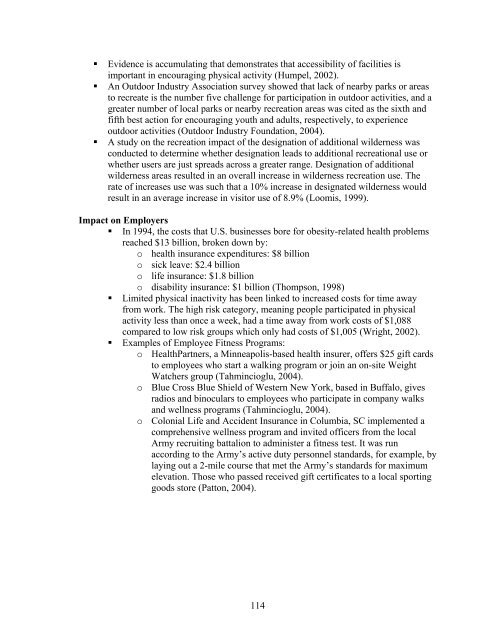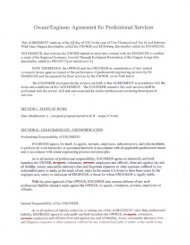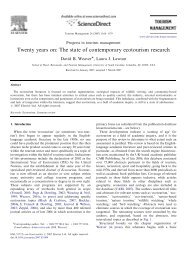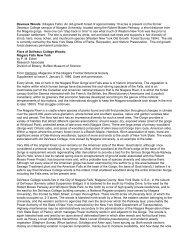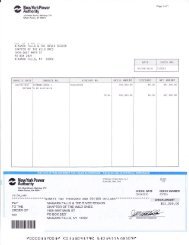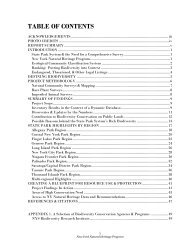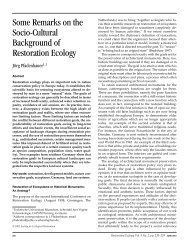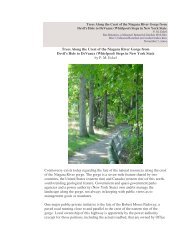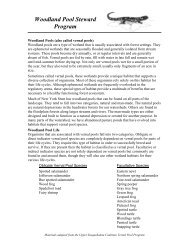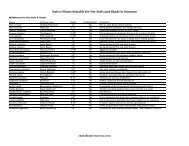costs than normal weight; moderate obesity increases health care costs by 18%(men) to 31% (women). Averaging across these four groups (men/women <strong>and</strong>moderate/severe obesity), there was a 44% increase in health care costs comparedwith people <strong>of</strong> normal weight (Sturm, 2004).Obesity may account for as much as a 36% increase in costs for inpatient <strong>and</strong>ambulatory care for individuals-a greater increase than that attributed to aging 20years, smoking, or problem drinking (Sturm, 2002).One report suggests that being active saves almost twice as much per person asbeing a non-smoker (Craig, 1994).Costs <strong>of</strong> obesity-related lost productivity in 1994 included 39 million lost workdays, 239 million restricted-activity days, 90 million bed days <strong>and</strong> 63 millionphysician visits (Wolf, 1998).Determining the total medical costs <strong>of</strong> obesity using claims data may underestimatecosts because claims are not always coded with an obesity diagnosis. However, datastill show that per-person claim costs for obese patients are about triple those for theaverage person, <strong>and</strong> the hospital admission rate is roughly 350 per 1,000 comparedto about 50 per 1,000 for an average commercial population (Fitch, 2004).The Wall Street Journal reports that by 2020, the treatment <strong>of</strong> medical problemsrelated to being overweight will comprise 20% <strong>of</strong> health-care dollars spent forpeople aged 50- 69. Severely obese older people, in particular, have about twice asmany chronic medical conditions (Rundle, 2004).People with diabetes had per capita medical expenditures <strong>of</strong> $13,243 while thosewithout diabetes spent only $2,560. After accounting for differences in age, sex, <strong>and</strong>race/ethnicity, diabetics had medical expenditures that were 2.4 times greater than ifthey had not had diabetes (USDHHS).Ferries in Puget Sound, Washington have widened their seats from 18 to 20 inches,<strong>and</strong> an ambulance company in Colorado retr<strong>of</strong>itted its vehicles with a winch a largecompartment to h<strong>and</strong>le patients who weight up to half a ton (Newman, 2004).In Louisiana, which is in particularly known for its food, statewide obesityattributableexpenditures total $1.37 billion (White, 2004).Americans are estimated to spend a total $44.5 billion in 2004 on diet services <strong>and</strong>products (Tahmincioglu, 2004), <strong>and</strong> they already spend $1 billion a year onprescription <strong>and</strong> over-the-counter weight-loss drugs (Park, 2004).Importance <strong>of</strong> Accessibility to <strong>Parks</strong> <strong>and</strong> <strong>Trails</strong> In one study, people with the best access to a variety <strong>of</strong> built <strong>and</strong> natural facilitieswere 43% more likely to exercise 30 minutes most days than those with poor access(Giles-Corti, 2002). Proximity to parks <strong>and</strong> trails is important for attracting certain segments <strong>of</strong> thepopulation. For example, older women who lived within walking distance <strong>of</strong> trails,parks or stores recorded significantly higher pedometer readings in one study thanwomen who did not, <strong>and</strong> the closer the destinations were, the more they walked(King, 2003). Similarly, children <strong>and</strong> adolescents are more active if they haveconvenient access to facilities or activity programs (Sallis, 2000). Longer distances to bikeways were associated with non-use <strong>of</strong> the MinutemanBikeway in Arlington, MA (Troped, 2001).113
Evidence is accumulating that demonstrates that accessibility <strong>of</strong> facilities isimportant in encouraging physical activity (Humpel, 2002).An Outdoor Industry Association survey showed that lack <strong>of</strong> nearby parks or areasto recreate is the number five challenge for participation in outdoor activities, <strong>and</strong> agreater number <strong>of</strong> local parks or nearby recreation areas was cited as the sixth <strong>and</strong>fifth best action for encouraging youth <strong>and</strong> adults, respectively, to experienceoutdoor activities (Outdoor Industry Foundation, 2004).A study on the recreation impact <strong>of</strong> the designation <strong>of</strong> additional wilderness wasconducted to determine whether designation leads to additional recreational use orwhether users are just spreads across a greater range. Designation <strong>of</strong> additionalwilderness areas resulted in an overall increase in wilderness recreation use. Therate <strong>of</strong> increases use was such that a 10% increase in designated wilderness wouldresult in an average increase in visitor use <strong>of</strong> 8.9% (Loomis, 1999).Impact on Employers In 1994, the costs that U.S. businesses bore for obesity-related health problemsreached $13 billion, broken down by:o health insurance expenditures: $8 billiono sick leave: $2.4 billiono life insurance: $1.8 billiono disability insurance: $1 billion (Thompson, 1998) Limited physical inactivity has been linked to increased costs for time awayfrom work. The high risk category, meaning people participated in physicalactivity less than once a week, had a time away from work costs <strong>of</strong> $1,088compared to low risk groups which only had costs <strong>of</strong> $1,005 (Wright, 2002). Examples <strong>of</strong> Employee Fitness Programs:o HealthPartners, a Minneapolis-based health insurer, <strong>of</strong>fers $25 gift cardsto employees who start a walking program or join an on-site WeightWatchers group (Tahmincioglu, 2004).o Blue Cross Blue Shield <strong>of</strong> Western New York, based in Buffalo, givesradios <strong>and</strong> binoculars to employees who participate in company walks<strong>and</strong> wellness programs (Tahmincioglu, 2004).o Colonial Life <strong>and</strong> Accident Insurance in Columbia, SC implemented acomprehensive wellness program <strong>and</strong> invited <strong>of</strong>ficers from the localArmy recruiting battalion to administer a fitness test. It was runaccording to the Army’s active duty personnel st<strong>and</strong>ards, for example, bylaying out a 2-mile course that met the Army’s st<strong>and</strong>ards for maximumelevation. Those who passed received gift certificates to a local sportinggoods store (Patton, 2004).114
- Page 1:
ECONOMIC IMPACTS OF PARKS, RIVERS,
- Page 4 and 5:
AcknowledgementsI am grateful to ma
- Page 6 and 7:
3.5.5 Sources of Information.......
- Page 8 and 9:
Table 28. Hiking/Walking Organizati
- Page 10 and 11:
1 IntroductionParks, rivers, trails
- Page 12 and 13:
Table 1.SectionAgency ExpendituresC
- Page 14 and 15:
provide communities with economic,
- Page 16 and 17:
the most current information on the
- Page 18 and 19:
3.1 Agency ExpendituresThis section
- Page 20 and 21:
grants. About 25% of capital expend
- Page 22 and 23:
The Marin Conservation Corps (MCC)
- Page 24 and 25:
already been implemented and is ope
- Page 26 and 27:
Table 5.Net Benefit Per Participant
- Page 28 and 29:
WEST VIRGINIAWISCONSINEarthCorpsFed
- Page 30 and 31:
contracts that gross over $800 mill
- Page 32 and 33:
3.2.2 Special EventsRevenue enhanci
- Page 34 and 35:
park experience to an audience who
- Page 36 and 37:
you have the opportunity to determi
- Page 38 and 39:
Use good survey methods. The better
- Page 40 and 41:
California. A Report to The Sierra
- Page 42 and 43:
powered activities 3 , a participan
- Page 44 and 45:
Table 11. 2003 Sport Footwear Purch
- Page 46 and 47:
3.3.4 Fish and Wildlife-Related Rec
- Page 48 and 49:
EQUIPMENT AND OTHER EXPENSESTotal $
- Page 50 and 51:
Table 17. Estimates of Retail Expen
- Page 52 and 53:
Table 19. U.S. Ski & Snowboard Indu
- Page 54 and 55:
and from services related to the Pa
- Page 56 and 57:
o $60 million in Harris County, TX,
- Page 58 and 59:
League ofAmericanBicyclistsNational
- Page 60 and 61:
SportingGoodsManufacturersAssociati
- Page 62 and 63:
necessarily better, especially in s
- Page 64 and 65:
Perspective. Available at http://ww
- Page 66 and 67:
o Washington: $209 milliono West Vi
- Page 68 and 69:
Economic Output Retail Sales Salari
- Page 70 and 71:
Economic Output Retail Sales Salari
- Page 72 and 73: Table 35. Economic Impact of Sportf
- Page 74 and 75: All Anglers Non-Resident/Tourist An
- Page 76 and 77: Table 37. Per Capita Travel Receipt
- Page 78 and 79: their decision to return in the fut
- Page 80 and 81: Table 39. Visitors and Spending in
- Page 82 and 83: 2003). Data from California Departm
- Page 84 and 85: over 2003, despite high gas prices,
- Page 86 and 87: management changes or actions are e
- Page 88 and 89: accommodations used, and other trip
- Page 90 and 91: http://www.ncdot.org/transit/bicycl
- Page 92 and 93: 3.5 Estimating the Effects of Spend
- Page 94 and 95: “leakage” of money from the reg
- Page 96 and 97: Keep in mind that multipliers are s
- Page 98 and 99: 3.5.4 How to Use These Rationales i
- Page 100 and 101: economy, only those expenditures th
- Page 102 and 103: For example, be aware of the differ
- Page 104 and 105: 3.6 Health Care and FitnessThis sec
- Page 106 and 107: active, approximately $575 million
- Page 108 and 109: already had one heart attacko Impro
- Page 110 and 111: uilt as part of sound policy to pro
- Page 112 and 113: accounting for 14 million disabilit
- Page 114 and 115: park amenities available or do not
- Page 116 and 117: National Coalitionfor PromotingPhys
- Page 118 and 119: 100% of all health benefits to a si
- Page 120 and 121: Pratt M, Macera CA, Wang G. 2000. H
- Page 124 and 125: References for Additional Informati
- Page 126 and 127: 3.7 Benefit EstimationParks, rivers
- Page 128 and 129: Table 47.Forecasted Average Benefit
- Page 130 and 131: Table 48.CriteriaRecreationExperien
- Page 132 and 133: people using carefully designed and
- Page 134 and 135: special government funds for causes
- Page 136 and 137: Loomis, J. B., and White, D.S. 1996
- Page 138 and 139: Economic Assessment for the Necedah
- Page 140 and 141: Commercial UsesExpenditures byResid
- Page 142 and 143: Outcomes Expenditures by GGNRA mana
- Page 144 and 145: local transportation admissions and
- Page 146 and 147: 3.8.8 Educational ValueWhile it may
- Page 148 and 149: the same municipality that are furt
- Page 150 and 151: that do require storm water managem
- Page 152 and 153: Summary of ActionsSimilar to corpor
- Page 154 and 155: 3.9 Resource Book AppendicesSeveral
- Page 156 and 157: 6. Spending in the area. Please rep
- Page 158 and 159: local economy aren’t bringing in
- Page 160 and 161: 4 ConclusionIn 1995, the National P


